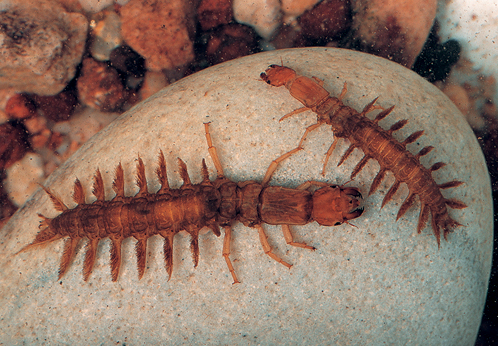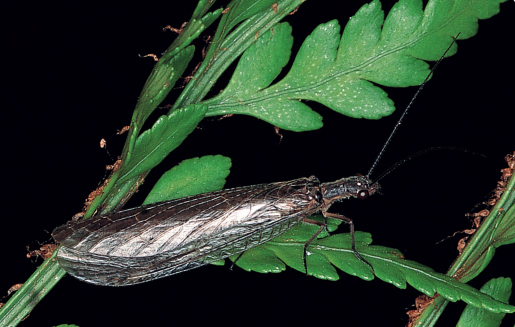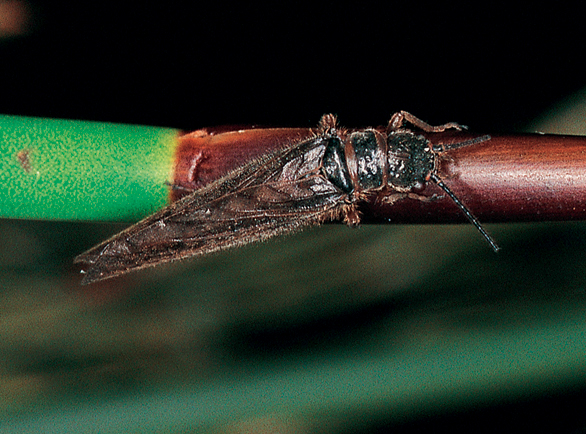
© D. STEVENS & M. PICKER
13 |
Text by Mike Picker and Duncan Stevens |
|---|---|
Dobsonflies, fishflies and alderflies
Order Megaloptera

© D. STEVENS & M. PICKER

© D. STEVENS & M. PICKER
A small insect order made up of two families, large-bodied Corydalidae (dobsonflies and fishflies) and smaller Sialidae (alderflies). The majority of African species are restricted to South Africa, apart from a few Corydalidae in Madagascar and one Egyptian alderfly. Considered a relict group (once more widespread globally), and typically encountered in mountain streams, but occasionally also in slower-flowing rivers. Larvae (‘toe-biters’) (1) have abdominal processes (filamentous extensions), each with a tracheal gill at its base, along each side of the abdomen, and go through 10 moults in a life cycle lasting at least two years; whereas the adults live only a few days. Larvae occur under stones and feed on aquatic invertebrates. Pupation takes place in mud cells under stones and in moss in damp soil around stream margins. Adults (2) have large dull brown or grey wings (short-winged forms are rare), an elongated prothorax and large eyes. They are encountered along shaded river margins in late summer during a sometimes short emergence period. Brown eggs are laid in large masses on rocks or marginal vegetation, hatched larvae dropping into the water. Adults are attracted to lights.
3 Alderflies
Family Sialidae


© D. STEVENS & M. PICKER

© D. STEVENS & M. PICKER
Larvae with seven pairs of lateral abdominal gills and a single, long, trailing filament at end of abdomen (3). Adults lack ocelli between compound eyes; wings elongated, brown-black, furled around abdomen. Size: Wingspan 23mm, larvae 12mm in length. Biology: Two uncommon species in the region, Leptosialis africana (3a) from high-altitude streams of the southern parts of the Western Cape, and L. necopinata from more slow-flowing turbid rivers and even dams in the Eastern Cape and KwaZulu-Natal. L. africana adults have much narrower forewings than L. necopinata. Larvae of former have marbled markings on head capsule, absent in latter species. Adults sluggish, found on marginal vegetation. Larvae occur in soft sediments and probably feed on caddisfly larvae.
Dobsonflies and fishflies
Family Corydalidae
Adult Corydalidae have three ocelli (simple eyes) between the compound eyes, and apparently do not feed. The wings are loosely furled around the abdomen, and they have a slow fluttering flight. Larvae have eight pairs of lateral abdominal processes and a pair of leg-like claws on the last abdominal segment, used to anchor them to rocks.
4 Dobsonflies
Subfamily Corydalinae


© D. STEVENS & M. PICKER

© D. STEVENS & M. PICKER

© D. STEVENS & M. PICKER
Large to very large; adults with sharp projection behind eyes (4); head and first part of thorax with clear black stripes, males with serrated antennae. Larvae bristly, with seven pairs of conspicuous tracheal gills at bases of feathery lateral abdominal processes (4a). Cone-shaped upper lip (labrum) of adults, pupae and larvae (4b) is characteristic of the genus. Size: Wingspan up to 170mm; larvae 40mm in length. Biology: A single genus and species, Chloroniella peringueyi, found in the Western Cape.
5 Fishflies
Subfamily Chauliodinae


© D. STEVENS & M. PICKER

© D. STEVENS & M. PICKER

© D. STEVENS & M. PICKER
Smaller than dobsonflies; head smooth, without projections behind eyes; no stripes on head and first part of thorax. Larvae smooth, lacking tracheal gills at bases of the lateral abdominal processes, which are less feathery than in Chloroniella. Labrum 3× wider than its length in both adults and larvae (5). Two genera occur in mountain streams from the Western Cape to KwaZulu-Natal, frequently coexisting. Eight species of Taeniochauliodes, with ocelli (5a) almost touching one another, and three species of Platychauliodes, with ocelli (5b) spaced widely apart. Size: Wingspan 90mm (Platychauliodes) to 130mm (Taeniochauliodes); larvae 30mm in length. Biology: T. ochraceopennis is the largest, commonest and most widespread fishfly in the region, adults emerging November–February in the Western Cape.